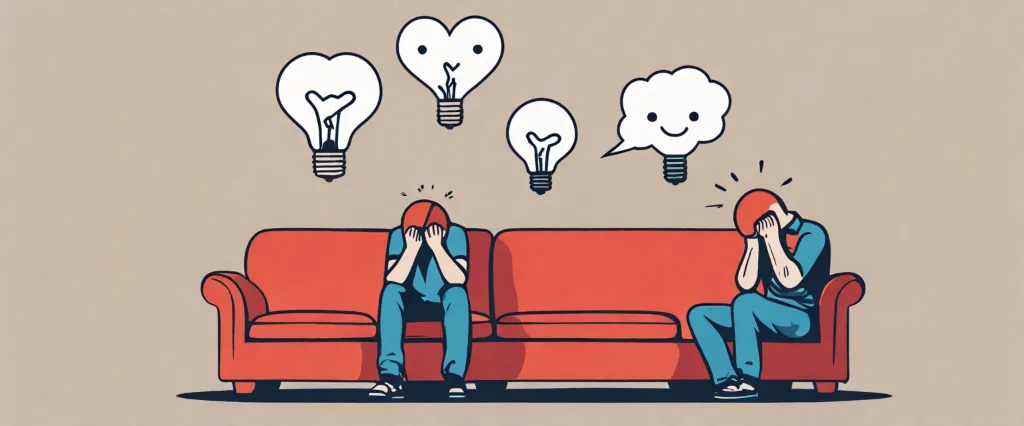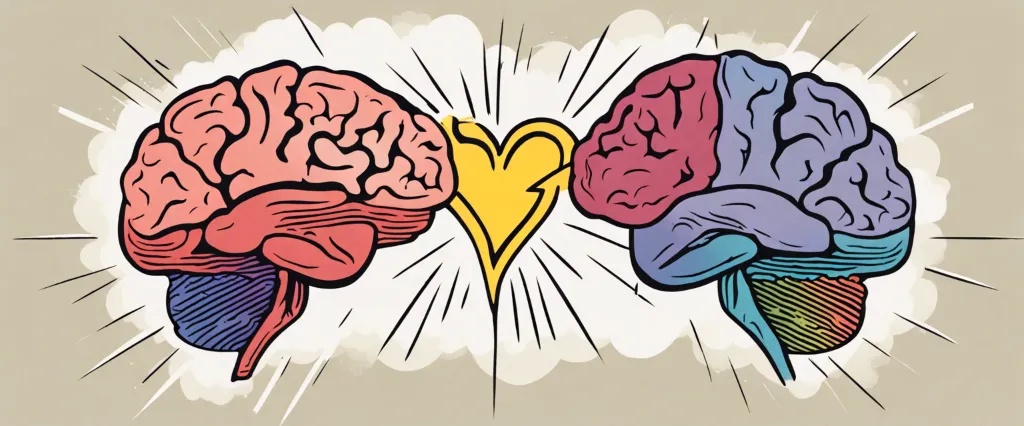——Emotional First Aid by Guy Winch & The Emotional Life Of Your Brain by Richard J. Davidson

In an increasingly complex world, where demands and stressors are consistently on the rise, understanding and managing our emotions become paramount to our overall well-being. The realm of emotional intelligence, often overlooked or undervalued, holds immense potential in guiding us towards leading more fulfilling lives. In this comparative study, we delve into the depths of two thought-provoking books, “Emotional First Aid” by Guy Winch and “The Emotional Life Of Your Brain” by Richard J. Davidson, both of which offer a unique perspective on the art of emotional wellness.
Guy Winch’s “Emotional First Aid” serves as a practical guide, focusing on the effective management of everyday emotional injuries that often go untreated. Winch, a clinical psychologist, presents a compelling argument on the detrimental consequences of ignoring our emotional wounds and the importance of addressing them properly. Drawing upon numerous anecdotal experiences, psychological research, and therapeutic interventions, Winch offers an array of tangible techniques to heal distress, build resilience, and develop emotional strength.
On the other hand, Richard J. Davidson’s “The Emotional Life Of Your Brain” delves deeper into the neurological aspects of our emotional experiences. Davidson, a renowned neuroscientist, provides a comprehensive exploration of the brain’s role in shaping our emotions and influencing our well-being. Through his groundbreaking research on the brain’s plasticity and the effects of mindfulness, Davidson unveils a wealth of knowledge on how we can harness the power of our minds to reshape our emotional experiences and promote long-term emotional resilience.
While both books share a common objective of enhancing emotional well-being, their approaches differ significantly. Winch focuses on practical strategies that can be readily implemented in everyday life, offering immediate relief and long-term growth. On the other hand, Davidson takes a scientific approach, delving into the underlying mechanisms of emotions and proposing innovative ways to rewire the brain for lasting emotional balance.
Over the course of this comparative study, we will explore the strengths and limitations of each book, critically assessing their strategies, theories, and applications. By analyzing the distinct perspectives and insights offered by Winch and Davidson, we aim to foster a deeper understanding of emotional wellness and equip readers with a broader range of tools to navigate the intricate landscape of their emotions.
Through studying these two remarkable works, we hope to provide a comprehensive guide to harnessing emotional intelligence, empowering readers to embark on a transformative journey towards emotional healing, growth, and fulfillment.
Brief Summary of Two Books
Emotional First Aid by Guy Winch
“Emotional First Aid” by Guy Winch is a self-help book that explores the importance of addressing and healing emotional wounds. The author emphasizes that just as physical injuries require immediate attention, so do emotional injuries. Winch provides practical strategies and techniques to manage and heal emotional pain, including rejection, loneliness, failure, and guilt. He offers insights on building resilience and improving emotional well-being, encouraging readers to take care of their emotional health. The book serves as a comprehensive guide in developing emotional first aid skills to foster a healthier and more fulfilling life.
The Emotional Life Of Your Brain by Richard J. Davidson
“The Emotional Life of Your Brain” by Richard J. Davidson explores the relationship between our emotions and the functioning of our brain. Davidson, a renowned neuroscientist, delves into the complexities of emotions and reveals the latest findings from the field of neuroscience.
The book begins by explaining the concepts of positive and negative emotions, emphasizing that they are not simply fixed traits but rather dynamic states that can be influenced and changed. Davidson argues that the brain can be trained to cultivate positive emotional states such as happiness, resilience, and compassion, while reducing negative emotions like anxiety, depression, and stress.
Davidson also explores the concept of emotional style, which refers to the unique patterns of emotional reactions that vary among individuals. He delves into six emotional styles: resilience, outlook, social intuition, self-awareness, sensitivity to context, and attention. Through detailed case studies and scientific evidence, Davidson demonstrates how these emotional styles are associated with specific patterns of brain activity and how they can influence our happiness and well-being.
Furthermore, the book discusses the impact of early-life experiences, genes, and the environment on emotional development. Davidson explains the concept of emotional contagion, whereby our emotions can be influenced by those around us. He also provides insight into the effects of various meditation practices on emotional well-being and brain function.
In conclusion, “The Emotional Life of Your Brain” offers a comprehensive understanding of emotions and their connection to brain activity. Davidson provides readers with practical strategies to harness the power of emotions, rewire their brain circuits, and cultivate positive emotional states for a happier and more fulfilling life.
Comparison between Two Books

Similarities in Emotion Management
The two books, “Emotional First Aid” by Guy Winch and “The Emotional Life Of Your Brain” by Richard J. Davidson, both explore the topic of emotion management from different perspectives. Despite their differences in approach and style, there are several key similarities in how they discuss emotional well-being.
1. Recognizing and normalizing emotions: Both books emphasize the importance of acknowledging and accepting one’s emotions. They encourage readers to recognize that experiencing different emotions is a natural part of life and not something to be ashamed of. By normalizing emotional experiences, they aim to eliminate the stigma often associated with discussing and managing emotions.
2. Identifying emotional triggers: Emotional First Aid and The Emotional Life Of Your Brain focus on helping readers identify the specific events, situations, or thoughts that trigger their emotions. They highlight the necessity of understanding these triggers as a first step towards effectively managing and regulating emotions. By identifying these triggers, individuals can develop strategies to respond more appropriately and adaptively.
3. Strategies for emotional regulation: Both books offer practical techniques and strategies to regulate and manage emotions effectively. Emotional First Aid lays out specific steps to take in situations such as dealing with rejection, failure, or loss, while The Emotional Life Of Your Brain explores various methods for cultivating positive emotions and reducing negative ones. Both books emphasize the importance of practicing emotional regulation regularly to enhance overall well-being.
4. Mindfulness and self-awareness: Mindfulness and self-awareness are key themes in both Emotional First Aid and The Emotional Life Of Your Brain. Both authors stress the importance of being present in the moment and paying attention to one’s thoughts and emotions. By cultivating mindfulness and self-awareness, individuals can better understand and respond to their emotions in healthier and more resilient ways.
5. Seeking professional help: Finally, both books emphasize the significance of seeking professional help when necessary. They recognize that sometimes managing emotions can be challenging, particularly when dealing with trauma, severe mental health issues, or persistent emotional struggles. Both authors encourage readers to reach out to trained professionals who can provide appropriate guidance and support.
In summary, Emotional First Aid by Guy Winch and The Emotional Life Of Your Brain by Richard J. Davidson share several similarities in their approach to emotion management. Both books emphasize the importance of recognizing, understanding, and regulating emotions while offering practical strategies for achieving emotional well-being. They underscore the significance of self-awareness, mindfulness, and seeking professional help when needed.
Divergences in Emotion Management
Emotional First Aid by Guy Winch and The Emotional Life of Your Brain by Richard J. Davidson are two books that both delve into the subject of emotions and provide strategies for managing them. However, there are some divergences in their approaches toward emotion management.
1. Focus on Healing vs. Neuroscience:
One notable difference between the two books is their primary focus. Emotional First Aid by Guy Winch primarily focuses on healing emotional wounds and offering practical techniques for dealing with specific emotional injuries such as rejection, guilt, and failure. The book emphasizes the importance of addressing emotional pain promptly and provides step-by-step strategies to recover from various emotional setbacks.
In contrast, The Emotional Life of Your Brain by Richard J. Davidson takes a more scientific approach to emotion management. Davidson, a renowned neuroscientist, explores the connection between the brain and emotions. He explains how the brain’s neural circuits shape our emotional responses and provides insights into leveraging this knowledge to cultivate positive emotional states.
2. Personal Experience vs. Scientific Evidence:
While both authors draw on personal anecdotes and experiences to support their claims, Emotional First Aid by Guy Winch places a greater emphasis on the author’s personal encounters with emotional struggles. This makes Winch’s approach more relatable and empathetic, as he incorporates stories from his clients and personal life. By sharing his own and others’ experiences, Winch aims to offer practical advice that readers can connect with on an emotional level.
On the other hand, Richard J. Davidson’s book takes a more research-based approach. Davidson extensively references scientific studies and experiments to support his theories and recommendations. He explores various brain imaging techniques, neurofeedback, and other scientific findings to back up his assertions about the nature of emotions and how they can be managed effectively.
3. Emphasis on Specific Techniques:
Emotional First Aid by Guy Winch dedicates significant portions of the book to providing specific techniques and exercises that readers can immediately apply in emotional distressing situations. These techniques include reframing, cognitive restructuring, and self-compassion exercises, among others. Winch emphasizes the importance of practical tools to help individuals navigate emotional wounds and promote overall well-being.
Meanwhile, The Emotional Life of Your Brain by Richard J. Davidson focuses more on broader concepts and strategies for emotional well-being. Davidson explores the six dimensions of emotional style, including resilience, outlook, and self-awareness. While he does provide some practical exercises throughout the book, the emphasis is more on understanding the science behind emotions and how to shape one’s emotional style for positive outcomes.
In conclusion, Emotional First Aid by Guy Winch and The Emotional Life of Your Brain by Richard J. Davidson approach emotion management from different angles. Winch offers practical techniques to heal emotional wounds, using personal experiences to connect with readers. In contrast, Davidson focuses on the neuroscience behind emotions, providing insights into how the brain contributes to emotional experiences and how to cultivate positive emotional states. Both books provide valuable perspectives and strategies, catering to different preferences and needs when it comes to managing emotions.

Conclusion
Both “Emotional First Aid” by Guy Winch and “The Emotional Life of Your Brain” by Richard J. Davidson offer valuable insights and guidance regarding emotions and mental well-being. The choice ultimately depends on personal preference and specific interests.
Here’s a brief overview of each book:
1. “Emotional First Aid” by Guy Winch: This book focuses on practical strategies for healing emotional wounds and building resilience. Winch provides a collection of techniques to address common emotional injuries such as rejection, guilt, and failure. The emphasis is on actionable steps to implement in everyday life.
2. “The Emotional Life of Your Brain” by Richard J. Davidson: Davidson, a renowned neuroscientist, explores the interdisciplinary field of affective neuroscience. He explores how emotions and brain activity intertwine, delving into topics such as decision-making, well-being, and emotional resilience. The book combines scientific research with practical strategies for enhancing emotional intelligence.
Ultimately, the choice comes down to personal preference. If you are seeking immediate strategies for emotional healing, “Emotional First Aid” may be a better fit. However, if you are interested in a more scientific exploration of emotions and brain activity, “The Emotional Life of Your Brain” might be the preferred option.


